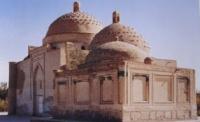You are here
Mausoleum of Bayan-Kuli-Khan.

Tours of historical and architectural monuments of Bukhara.
“Destroying monuments, keep pedestals. They can always come in handy”
Stanislav Jerzy Lec.
Hiking season in the mountains of Uzbekistan.
One of the students of Sheikh Safe ad-Din Boharzi was Chingizid Bayan-Kuli-Khan (died 1358). In 1346, Amir Kazagan seized power in the western part of the Mongolian ulus of Chagatayev, to which Bukhara belonged. He did not belong to the Chingizid family and ruled on behalf of Bayan-Kuli-Khan.
When power passed to the son of Kazagan, Amir Abd-Allah, he executed Bayan-Kuli. Bayan-kuli-Khan was buried next to the mausoleum of Sheikh Boharzi. Under the Temurids a small mausoleum was erected there, featuring a rich ornamental finish with carved glazed terracotta.
Around 1358, near the tomb of the famous Central Asian mystic Seyfeddin-Bokharzi (died 1261), the mausoleum of the Mongol khan Buyan - kuli-khan (died 1358) is being built. This two-chamber building consists of ziarathans and gurkhans, with a narrow corridor.
The main facade, highlighted by the portal, is raised above the rest, covering the squat domes of the premises. On the facades of the building and in the interior of Ziaratkhana, carved irrigated terracotta (in many areas lost) dominated by large slabs dominates, and in stalactite filling of the sails - in whole blocks.
The ornamentation is dominated by girikhs, imitations on the plates of brickwork, but mostly - the finest vegetation plexuses and whimsical ligature of inscriptions. In color prevails a bright blue color, complemented by white and blue.
The building above the burial of Seyfeddin Boharzi (the IInd half of the XIVth century) adjoins the basement of the Buyan-Kuli Khan mausoleum. It is also two-chamber (gurkhan and ziarathana), but it is excellent in composition and more significant in scale.
Both rooms are topped with ovoid domes; the ziarathan dome dominates. The side facades are highlighted with arches in rectangular frames. The burial is marked with a three-level majolica tombstone. The prismatic volume of the mausoleum comprises two rooms: a domed hall - a zirethan and a dark tomb behind it, circled along the corridors, as was done in Buddhist temples.
The main artistic value of the mausoleum is carved glazed terracotta and minicolored tiles that adorn the inside and outside. Gamma 11 colors characteristic of pre-Timurovskoy pores: blue, manganese-black, white and to a lesser extent - blue.
The platform on which the mausoleum stands is lined with a traditional motif: clay brick masonry with blue glazed inlays "bows" on the vertical walls, and its surface is lined with parquet in the form of six-sided drafts in a rectangular edging.
This monument was created before the famous Timur tombs Shah-i-Zinda, but can compete with the best of them. His architectural decision was innovative for its time: this is one of the earliest examples of a two-chamber mausoleum.
One of the disciples of Saf al-Din Boharzi was the Chagatay Khan Buyan-Kuli (dated 1935), the grandson of the famous Duan Khan (died in 1307). In 1346, Amir Kazagan seized power in the western part of the Mongol ulus of Chagatayev, to which Bukhara belongs.
He formally elevated Buyan-kuli-Khan to the throne and ruled on his behalf. When power passed to the son of Kazagan, Amir Abd-Allah, he executed Buyan-Kuli-Khan. One of the reasons for this is the desire of Abd-Allah to get the wife of Buyan-Kuli-Khan.
The deceased Khan was buried next to the memorial of his teacher Sheikh Boharsi. Here the mausoleum of impressive forms was erected at the same time attracts with simplicity and clarity. The mausoleum has a complex plan, so it has a tomb (gurkhan), a room of commemoration (ziyaratkhon).
And above it are two domes. Inside the mausoleum, all the walls are decorated with carved glazed terracotta of blue, blue and white tones. The gravestone is made of wood in the XIV century. There is also a secret corridor whose destination has not yet been clarified.
The main facade is decorated with a slender arch portal. Which almost does not protrude, but only raised relative to the wall section. The main facade is highlighted by a monumental portal (XV century or XVI century) with a vault and a crowning arcature, turrets at the corners and three-tiered walls.
The interior of Ziaratkhana is spacious and light; its stalactite domes are peculiar. In the gurkhan there is a wooden tombstone of the end of the XIV century, decorated with ornamental carvings with a predominance of intricate floral motifs and script letters.
Enlightener:
Pugachenkova G.A., V.G. Saakov “History of Bukhara”. Shark Publishing House, 1996. “Bukhara.
Photos by
Alexey Arapov.







